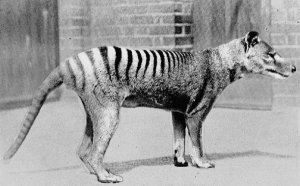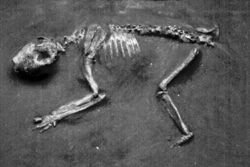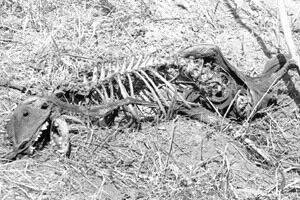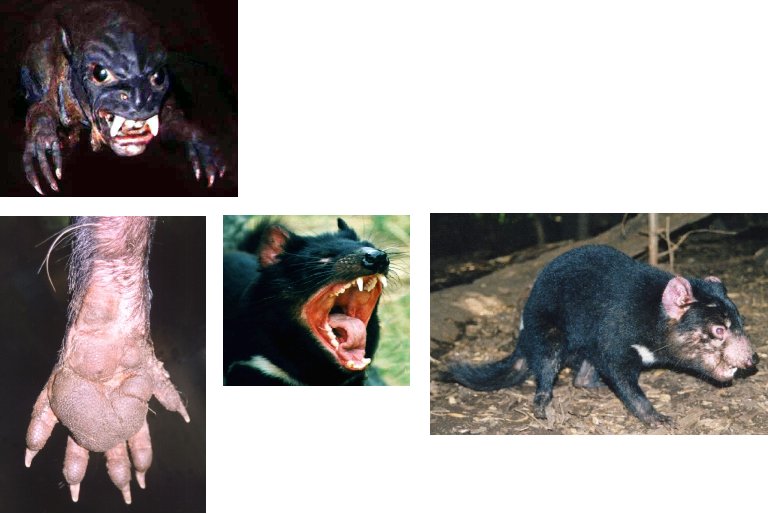"On September 7, 1936, the last known Tasmanian tiger dies in captivity in the zoo of Hobart in Tasmania. [...]
In 1986, the Tasmanian tiger [thylacine] was officially declared extinct but many mysteries remain in connection with this animal. Several inhabitants of Tasmania living at the edge of the forests believed to have seen some. They found animals carrying of the traces of the jaw of the thylacine. [...]
Villagers of Irian Jaya in Indonesia certify to have seen a livin Tasmanian tiger in the hills around the border between Indonesia and New Guinea. The animal would live in the caves of the area of Kurima around the Oksibil and Okbibab villages and seems to attack the domestic animals at night. [...]
Scientists hope to use an extracted DNA sequence to create a clone and to give this disappeared species a new departure."
Source: Article on www.futura-sciences.com/decouvrir/d/dossier270-1.php

|
You can find more detailed information in the cited reference at the end of this page. Here some basic facts.
Tasmanian wolf, Tasmanian tiger, Thylacine, Thylacinus Cynocephalus.
The most impressive biological characteristic with the Tasmanian tiger is that although it has a morphology resembling that of a strange dog, it is not at all a placental mammal, but a marsupial, like the kangaroo, the koala, the opossum, the wombat, the bandicoot.
The Tasmanian tiger was a widespread animal on the Australian continent including of course Tasmania, an island close to the Australian mainland, but also in New Guinea.
Before the colonization of Australia, the Tasmanian tiger was a predator of local fauna, from small rodents to the kangaroo. After the colonization they were known to attack the sheep and poultry of the stockbreeders.
The Tasmanian tiger is considered an extinct species. A reason called upon for its disappearance in Australian mainland is that he was ecologically in competition with the dingo, but it cannot be silenced that it had been slaughters on behalf of the stockbreeders of sheep of Tasmania who suspected it of decimating their herds.
Although the last thylacine is supposedly deceased at the Hobart zoo in 1936 (*), there is a considerable number of people who claim to have seen one later, in New Zealand in Australia, and in Indonesia. Certain testimonies (p. ex in Pyengana, Tasmania, in 1995) are compelling, however no tangible proof was produced so far.
(*) The species had just been declared a protected species.

Thylacine fossil. |

Alleged remains of a chupacabras. |
The photograph of animal remains shown above was described as remains of a chupacabras by the local press and apparently the inhabitants of the area. There were debates as to what the animal was supposed to be, theories including an ordinary dog, not a dog at all, or a dog but of an unknown species.
It seems that the photograph shows an animal which can be interpreted as being situated somewhere between cat-like and dog-like. It seems completely obvious that these remainders do not indicate the least reason to call upon an unspecified creature coming from another planet. Most probably, it is indeed a terrestrial animal, possibly rather different from usual canine and cat-like, which is what puzzle the commentators.
It seems that if serious research had been done, such as comparisons between these remains including a quasi intact skeleton and other skeletons, such that of Thylacine, there would have perhaps be a solution, perhaps both simple and fantastic.
When it was told that an animal living in Africa was seen, which was half zebra, half giraffe, it was not taken seriously at all in the first place. But the animal was quite real, and corresponded rather well to eyewitness description of "half zebra, half giraffe:" the okapi was indeed discovered. Some prudence should be considered before laughing from the start at all evocation of mysterious animals. But also, a minimum of common sense should make it possible to avoid assimilating any strange animal to an extraterrestrial beings: for example there is not the least reason to think that chupacabras if it exists, is extraterrestrial. It may possibly be a rare, supposedly extinct, poorly known, or an animal whose presence is unusual in the concerned locations.
There are some interesting coincidences. Some of the reports on domestic animals attacked by chupacabras mentions that the victims had two holes brought closer on cranium. It so happens that the Tasmanian tiger, just like its cousin the smaller and squater Tasmanian devil, has a capacity to very largely open its jaws, to seize the cranium of its prey (kangaroo, goat...) and literally to bore the bone, with its conical and marked canines being quite different than those of dogs and wolves, thus creating a rather different impression from that of the bites of carnivorous mammals. Certain Tasmanian sources also state that, following the example of the kangaroo, it so happens that the Tasmanian tiger makes jumps on its back legs back in cases of emergencies or stress.
There is no doubt that in the years just before and after the World War I, a certain traffic of Tasmanian tiger towards the zoos of Europe and private individuals had taken place. One of the most famous exporters was named Elias Joseph and was of Sydney. He was in business with highly skilled trappers such as Bill Power, William O' May, Jake Ellis, Jim Bryant, who captured Tasmanian tigers for him, the latter finishing in European and American zoos. Starting in 1805, London zoo sheltered two specimens of them, while having imported a score, their last specimen dying there in 1931. It is also interesting to note that the animal was always discrete and difficult to locate, even in the first times of the arrival of colonists in Tasmania.

Above left: an artist's view, made after a description of a chupacabras by an eyewitness.
The other pictures: tasmanian devil. Not visible on the pictures, the reddish eyes both mentioned in many chupacabras reports and the colour of the Tasmanian devil's eyes.
It may be objected that it is not necessary to call upon exotic animals or supposedly extinct animals to get rid of the chupacabras mystery; but, if it is certainly possible, by the diffusion of mediatized alarms that any hen attacked by some fox may create an additional chupacabras report, it is possible all the same that initial reports cannot be explained so lightly. After all, peasants and farmers of Latin America have been disturbed by some unusual characteristics, the usual predators having nothing such as to puzzle them.
It may be objected that marsupials live only in Australia, but that is false. There are at least 70 different species of marsupials in Latin America and thus no reason to think that a colony of thylacines cannot exist there. A recent case of a rare marsupial found in Latin America and reported initially as a possible extraterrestrial being is described here. In addition, marsupials predators of similar aspect but genetically divergent (since 12 million years) to the Tasmanian tiger did exist in South America. Their species (borhyaenids) is extinct there since a few 5 million years, decimated by the arrival of new mammalian predators.
It may be objected that descriptions of chupacabras cannot correspond to the Tasmanian tiger nor have any close relation to any known terrestrial animals, as witnesses say to have seen chupacabras fly, or display differently more astonishing characteristics than those ascribable to a terrestrial predator. I do not reject the possibility, I did not really investigate any such cases and I am thus simply skeptic, which simply means that I do not believe from the start these more extraordinary accounts. Here, I am satisfied to note some common features between an alleged chupacabras remainders and a supposedly disappeared marsupial predator.
I simply speculate that some among the alleged reported chupacabras may be surviving Tasmanian tigers, others be devils of Tasmanian devils.